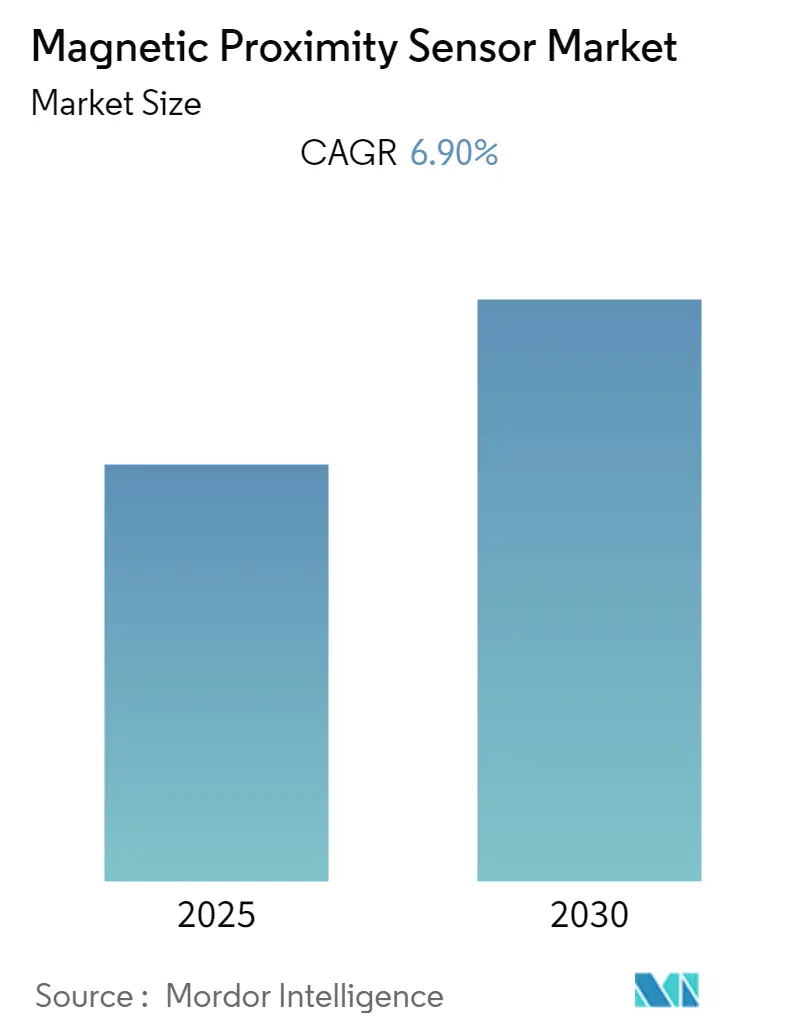
| Study Period | 2019 - 2030 |
| Base Year For Estimation | 2024 |
| Forecast Data Period | 2025 - 2030 |
| CAGR | 6.90 % |
| Fastest Growing Market | Asia Pacific |
| Largest Market | Asia Pacific |
| Market Concentration | Low |
Major Players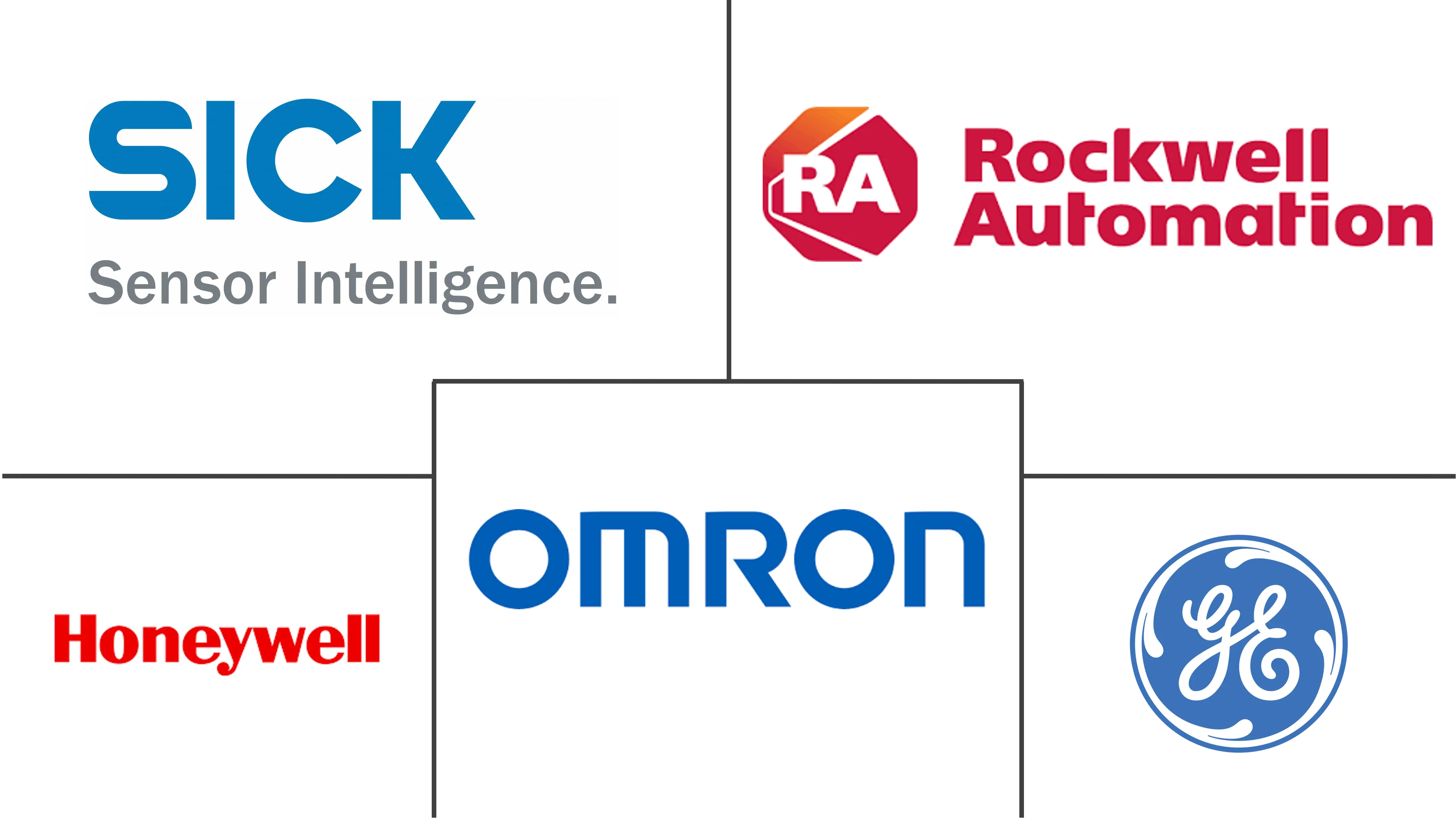
*Disclaimer: Major Players sorted in no particular order |
Magnetic Proximity Sensors Market Analysis
The Magnetic Proximity Sensor Market is expected to register a CAGR of 6.9% during the forecast period.
- The industrial automation segment emerged as a relatively more attractive space for investment by organizations worldwide. The dependence on robots in industrial controller mechanisms is an established trend that is paving the way for more extensive and broader adoption of industrial control and automation equipment.
- Governments are enforcing the safe use of sensors in every end-user industry, especially in healthcare devices that require detailed regulations to ensure safety for the end users from electrical, chemical, biological, and physical threats.
- Due to the growing demand for non-contact sensing technology, proximity magnetic sensors are projected to play a significant role in the market in the near future as they are used in a variety of applications, including aerospace and military, and automotive.
- The COVID-19 pandemic significantly impacted the market. It is anticipated that as the market recovers from the pandemic or in post pandemic situation, the growth trajectory will differ across regions, with some nations having enormous growth potential and others having low profit margins. Also, there is growing demand for electric and self-driving vehicles that are highly integrated with magnetic sensors. Thus, magnetic proximity sensor manufacturers are experiencing more opportunities in the market.
- However, the major challenge for this market may be the limitations in sensing technology, as it is expensive and needs expert personnel to analyze the readings that can be very complex to understand.
Magnetic Proximity Sensors Market Trends
Application in Automotive to Drive the Demand
- All varieties of proximity sensors, including position, magnetic, level, inductance, hall, digital, and others, are used in the production of automobiles. The increasing trend toward adopting electric mobility is also propelling the adoption of these sensors. During the forecast period, this trend is anticipated to fuel market expansion for magnetic proximity sensors.
- Magnetic proximity sensors in automobiles emit electromagnetic beams to scan for changes in the field. They are highly durable and have a wide sensitivity range. They also possess high stability, dependability, and consistency with a combination of magnets triggers. The customers can change the shell color, outlet direction, wire, terminal blocks, etc.
- Automobile motors are made of permanent magnets, contributing to their high efficiency, high power output, small size, and lightweight nature. A magnetic proximity sensor is used to monitor the performance of these functions and look for any defects.
- Additionally, the manufacturers now place a greater emphasis on passenger comfort and autonomous control due to the rising demand for light commercial vehicles. As a result, proximity magnetic sensors are crucial to the infrastructure of modern automobiles. The sales of light vehicles are still being driven by utilities and premium cars, which may help raise the demand for magnetic proximity sensors during the forecast period.
- Moreover, for speed and position sensing applications, hall-effect technology's wide frequency bandwidth, linearity, and high accuracy are essential. For angle-sensing applications, these sensors also offer contactless measurements and pre-programmability features. The market for automobiles may adopt Hall-based magnetic sensors more widely due to their capacity to maintain wide temperature stability in challenging environments.
- For instance, in May 2021, Allegro MicroSystems Inc. introduced a new magnetic sensing IC based on the 'Vertical Hall-effect' technology. For the automotive and industrial sectors, the new sensor has a small footprint and 3D position sensing capabilities. The ongoing technological developments in coreless Hall-effect sensors may drive the industry's growth over the forecast period.
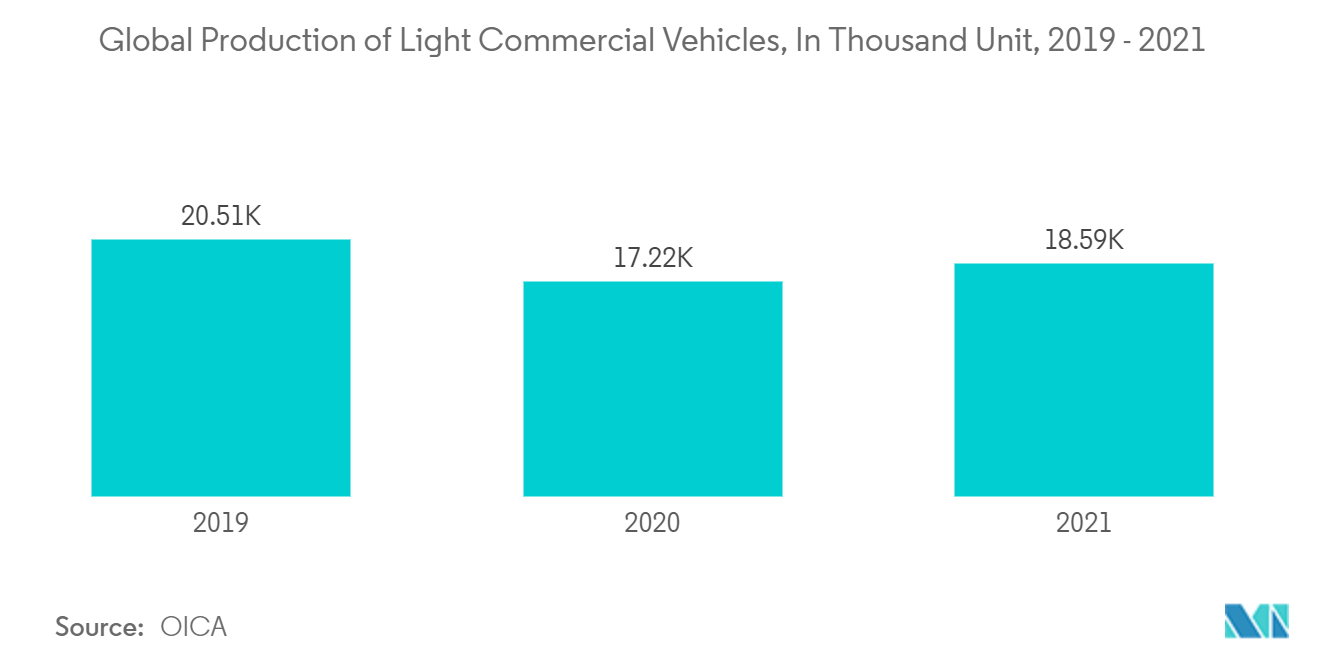
Asia-Pacific to Account for a Significant Market Share
- Asia-Pacific's magnetic sensor market captured the majority of revenue share because of the rapid proliferation of smart factories in the countries, including Japan, China, South Korea, and India. The major smart factory in the region was SAIC Volkswagen MEB, which focuses on the mass production of electric vehicles. Besides, the regional government announced an additional 100 new smart factories in the region by 2023.
- Similarly, in November 2020, the government of South Korea announced the deployment of 1,000 smart factories with 5G and AI capabilities in the country by 2025. These smart factories are highly integrated with automated machinery, production lines, conveyors, and industrial robots requiring magnetic sensors for position, speed, and distance sensing applications. Launching new smart factories may offer new opportunities for regional sensor vendors.
- The government has also taken initiatives for the safety of passengers in automobiles. As a result, magnetic proximity sensors have become essential parts of automobiles. This factor is expected to drive the proximity magnet sensor market during the forecast period. The vehicles are now equipped with different kinds of sensing devices that can take measures in case of danger.
- The AK8781 was introduced by Asahi Kasei Corporation in June 2020. It is a latch-type Hall IC with ultra-compact packaging that is appropriate for small DC brushless (BL) motors. It is the ideal packaging for high-temperature applications as it is compact and has a short response time. Through this launch, the company aims to advance the high efficacy and micro-miniaturization of DCBL motors.
- Factory automation is witnessing substantial growth in the region. These sensors are used for faster and more efficient production lines, as well as for sensing safety switches and proximity detection with high precision, repeatability, and accuracy.
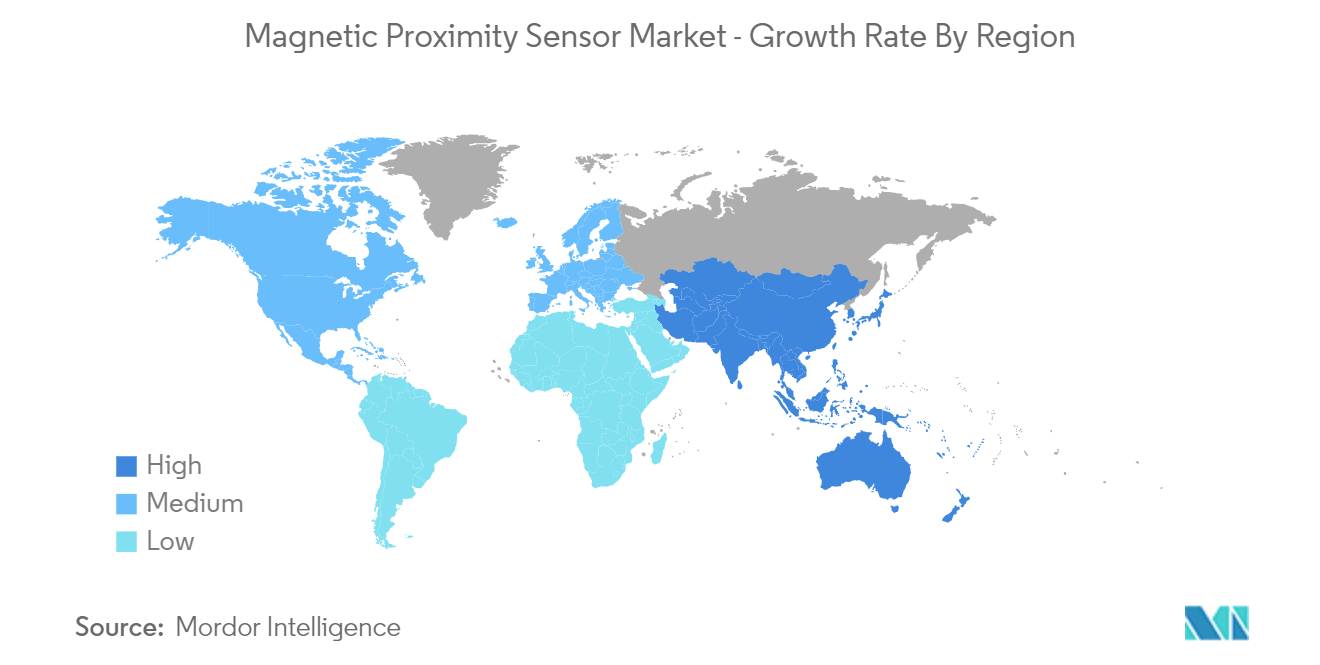
Magnetic Proximity Sensors Industry Overview
The market is significantly fragmented as there are several large and small players offering solutions. Some of the major players include General Electric, Eaton Corporation PLC, Rockwell Automation Inc., Omron Corporation, Panasonic Corporation, NXP Semiconductors NV, Honeywell International Inc., and Turck Inc.
- June 2022 - The A33110 and A33115 magnetic position sensors from Allegro MicroSystems Inc., a pioneer in sensing and power solutions for motion control and energy-efficient systems, went on sale. According to Allegro, the sensors are made for ADAS applications requiring high precision levels and heterogeneous signal redundancy.
- March 2022 - Standex International Corporation announced the acquisition of Sensor Solutions for roughly USD 9.7 million in cash. Sensor Solutions creates and manufactures specialized and standard Hall effect and magnetic proximity sensor products, including linear and rotating sensors, specialty sensors, and Hall switch and latching sensors. The consumer electronics, aerospace, automotive, industrial, medical, and healthcare industries use these products.
Magnetic Proximity Sensors Market Leaders
-
Sick AG
-
Omron Corporation
-
Honeywell International Inc.
-
Rockwell Automation
-
General Electric
- *Disclaimer: Major Players sorted in no particular order
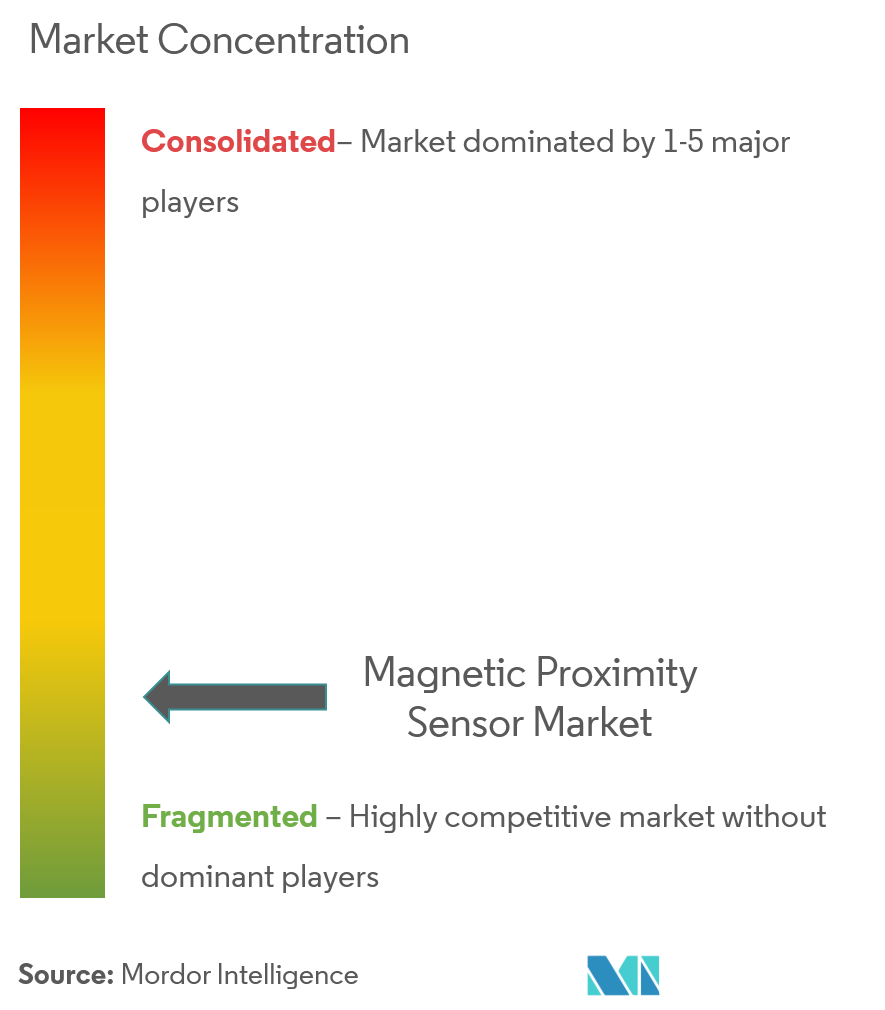
Magnetic Proximity Sensors Market News
- November 2022 - Allegro MicroSystems Inc., a world leader in sensing and power solutions for motion control and energy-efficient systems, released the A31316 3D hall-effect position sensor, the latest model in the 3DMAG line of 3D sensors. Allegro's tried-and-true planar and vertical hall-effect technologies are combined to measure magnetic field components in the 3DMAG family of rotary and linear magnetic proximity sensor ICs for automotive and industrial applications.
- July 2022 - Edison Group launched a flagship smartphone with 6 GB RAM, named 'Helio 30'. The new smartphone has a G sensor, proximity sensor, light sensor, gyroscope sensor, and magnetic proximity sensor. The 'Helio 30' model phone was made at the Edison Industries factory of Symphony Mobile.
Magnetic Proximity Sensors Industry Segmentation
Magnetic proximity sensors have long sensing ranges that can detect magnetic objects, and the smaller magnets open up new application possibilities. MM sensors complete this comprehensive product family in NAMUR design for use in explosion-hazardous areas.
The magnetic proximity sensors are used to detect the position of magnetic objects without any contact via long sensing ranges that can penetrate all non-magnetizable materials, like aluminum, stainless steel, wood, plastic, etc. They are widely used in aerospace, defense, industrial, automotive, and other sectors.
The Magnetic Proximity Sensor Market is Segmented by Application (Aerospace and Defense, Automotive, Consumer Electronics, Building Automation, Others) and Geography (North America, Europe, Asia-Pacific, Latin America, and Middle East and Africa). The market sizes and forecasts are provided in terms of value (USD) for all the above segments.
| By Application | Aerospace and Defense |
| Automotive | |
| Consumer Electronics | |
| Building Automation | |
| Other Applications | |
| By Geography | North America |
| Europe | |
| Asia-Pacific | |
| Latin America | |
| Middle East and Africa |
Magnetic Proximity Sensors Market Research FAQs
What is the current Magnetic Proximity Sensor Market size?
The Magnetic Proximity Sensor Market is projected to register a CAGR of 6.9% during the forecast period (2025-2030)
Who are the key players in Magnetic Proximity Sensor Market?
Sick AG, Omron Corporation, Honeywell International Inc., Rockwell Automation and General Electric are the major companies operating in the Magnetic Proximity Sensor Market.
Which is the fastest growing region in Magnetic Proximity Sensor Market?
Asia Pacific is estimated to grow at the highest CAGR over the forecast period (2025-2030).
Which region has the biggest share in Magnetic Proximity Sensor Market?
In 2025, the Asia Pacific accounts for the largest market share in Magnetic Proximity Sensor Market.
What years does this Magnetic Proximity Sensor Market cover?
The report covers the Magnetic Proximity Sensor Market historical market size for years: 2019, 2020, 2021, 2022, 2023 and 2024. The report also forecasts the Magnetic Proximity Sensor Market size for years: 2025, 2026, 2027, 2028, 2029 and 2030.
Our Best Selling Reports
Magnetic Proximity Sensor Industry Report
Statistics for the 2025 Magnetic Proximity Sensor market share, size and revenue growth rate, created by Mordor Intelligence™ Industry Reports. Magnetic Proximity Sensor analysis includes a market forecast outlook for 2025 to 2030 and historical overview. Get a sample of this industry analysis as a free report PDF download.




